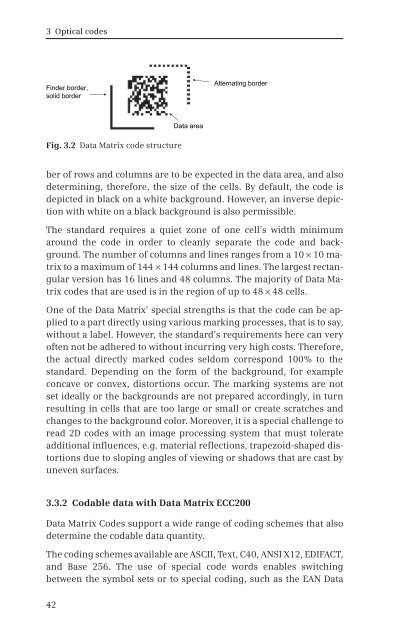Optimizing Processes with RFID and Auto ID, 2009
Optimizing Processes with RFID and Auto ID, 2009
Optimizing Processes with RFID and Auto ID, 2009
You also want an ePaper? Increase the reach of your titles
YUMPU automatically turns print PDFs into web optimized ePapers that Google loves.
3 Optical codes<br />
Finder border,<br />
solid border<br />
Fig. 3.2 Data Matrix code structure<br />
ber of rows <strong>and</strong> columns are to be expected in the data area, <strong>and</strong> also<br />
determining, therefore, the size of the cells. By default, the code is<br />
depicted in black on a white background. However, an inverse depiction<br />
<strong>with</strong> white on a black background is also permissible.<br />
The st<strong>and</strong>ard requires a quiet zone of one cell’s width minimum<br />
around the code in order to cleanly separate the code <strong>and</strong> background.<br />
The number of columns <strong>and</strong> lines ranges from a 10 × 10 matrix<br />
to a maximum of 144 × 144 columns <strong>and</strong> lines. The largest rectangular<br />
version has 16 lines <strong>and</strong> 48 columns. The majority of Data Matrix<br />
codes that are used is in the region of up to 48 × 48 cells.<br />
One of the Data Matrix’ special strengths is that the code can be applied<br />
to a part directly using various marking processes, that is to say,<br />
<strong>with</strong>out a label. However, the st<strong>and</strong>ard’s requirements here can very<br />
often not be adhered to <strong>with</strong>out incurring very high costs. Therefore,<br />
the actual directly marked codes seldom correspond 100 % to the<br />
st<strong>and</strong>ard. Depending on the form of the background, for example<br />
concave or convex, distortions occur. The marking systems are not<br />
set ideally or the backgrounds are not prepared accordingly, in turn<br />
resulting in cells that are too large or small or create scratches <strong>and</strong><br />
changes to the background color. Moreover, it is a special challenge to<br />
read 2D codes <strong>with</strong> an image processing system that must tolerate<br />
additional influences, e.g. material reflections, trapezoid-shaped distortions<br />
due to sloping angles of viewing or shadows that are cast by<br />
uneven surfaces.<br />
3.3.2 Codable data <strong>with</strong> Data Matrix ECC200<br />
Data Matrix Codes support a wide range of coding schemes that also<br />
determine the codable data quantity.<br />
The coding schemes available are ASCII, Text, C40, ANSI X12, EDIFACT,<br />
<strong>and</strong> Base 256. The use of special code words enables switching<br />
between the symbol sets or to special coding, such as the EAN Data<br />
42<br />
Data area<br />
Alternating border

















